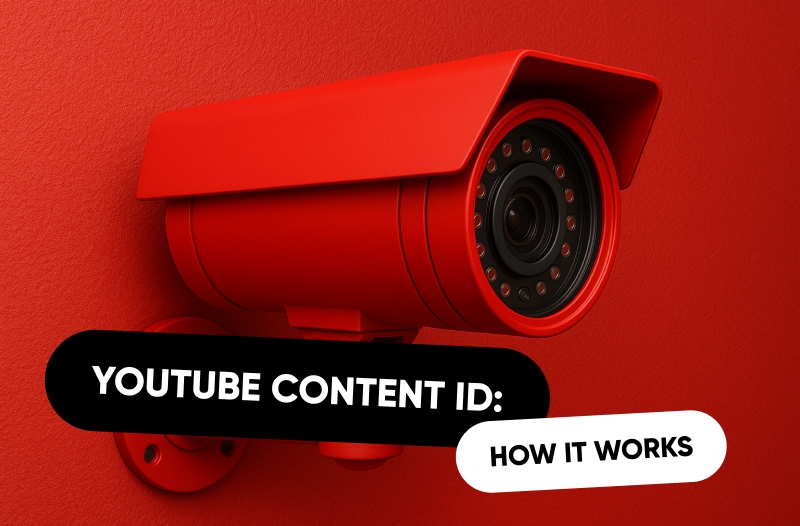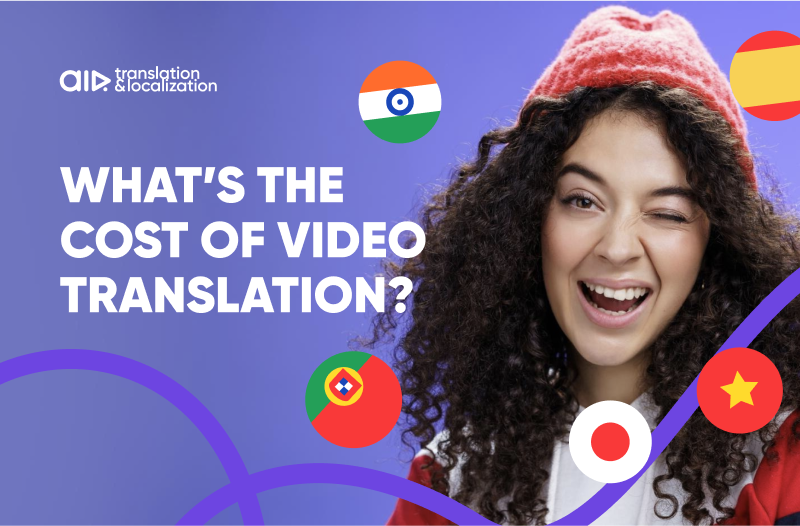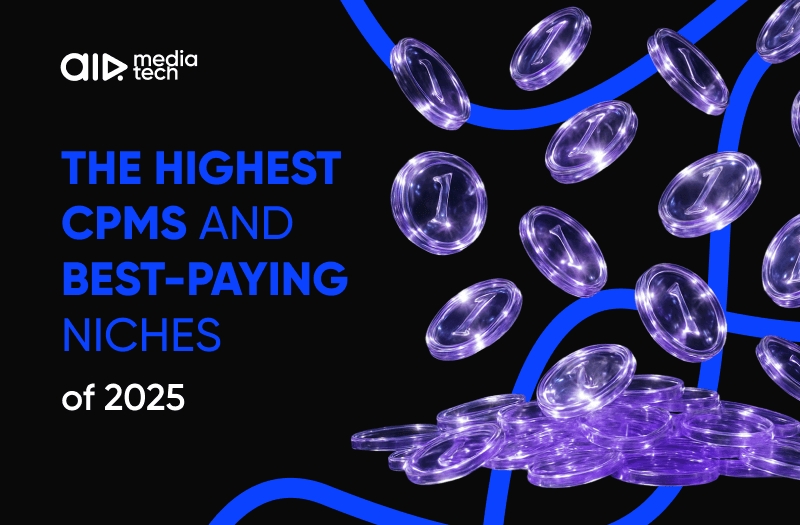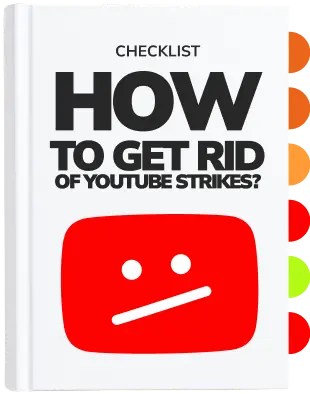
Content ID is YouTube’s advanced copyright protection system designed for content creators and copyright owners to keep their intellectual property safe. This guide will break down how Content ID works, its benefits, the challenges, and how you can use it to protect your content on YouTube.
What is Content ID
So what is Content ID? YouTube’s Content ID is a copyright protection system that helps creators protect their work. Unlike traditional copyright systems that simply block unauthorized content, Content ID goes further by allowing copyright owners to monetize third-party uses of their content. This means that if someone uploads your video without permission, you can still make money from it through ads rather than forcing a takedown.
Did You Know?
Content ID scans more than 500 hours of video uploaded to YouTube every minute, ensuring that your copyright-protected content is spotted and dealt with quickly.
How Content ID Works
Content ID works by scanning videos uploaded to YouTube against a database of files submitted to the platform by copyright owners. When the system identifies a match between uploaded content on YouTube and a copyright-protected work, the video receives a Content ID claim. The tool works in line with the DMCA and in turn, is supported and protected by it.
When dealing with unauthorized uploads, copyright owners can choose between options:
- To simply block them.
- To monetize them by running ads on the video.
- To track the video’s statistics.
The tool allows you to apply options to specific geographic areas. For example, you can monetize a video in one country and block or track in another.
Who Can Use Content ID
Not everyone has direct access to the Content ID system. YouTube has strict eligibility requirements for its use:
- You must own exclusive rights to the content (e.g., original videos, music).
- Typically, large companies, networks, and partnered creators are granted access.
- For smaller or independent creators, access to Content ID can be gained through YouTube partnerships or multi-channel networks (MCNs).
Because of strict YouTube policies for Content ID eligibility, you will need the assistance of your YouTube partnering company to receive access to the tool. YouTube does not grant access to individual content owners. That is why partnering up with AIR Media-Tech, as a YouTube partnering company, is a great way to get the safest copyright tool available. Contact us today to receive more information.
This restriction ensures that only those with clear ownership rights can make Content ID claims, reducing the risk of false or abusive claims.
How Content ID Works on Live Streams
Content ID isn’t just limited to pre-recorded videos—it also monitors live streams. As you stream live, the system scans for third-party content (like music or video clips). If it finds a match, the live streamer will get a warning to remove the content. But, unlike cases where a match of regular videos is found, the tool does not allow tracking or monetization on copies of your live streams and Content ID settings can’t be changed after the stream is created.
How Content ID Deals With Streams That Use Third-Party Content
- Once the match is identified, a violator will receive a warning.
- If they ignore it, the system will replace their stream with a static image and no sound.
- Finally, if the matching continues, the stream will be terminated and the streamer may lose access to live features.
Note that the policies do not apply to the authorized channels you specify in your allowlist.
Eligibility Criteria
To receive access to Content ID matching on live streams, you have to prove that:
- You have an issue-free history of operating the system.
- Your live content is time-sensitive. For example, you’re streaming an event.
- There’s a high chance that other users will use your content in their streams.
You can find out more about how Content ID works on live streams in the vast YouTube rulebook.
Content ID Claim
If the system identifies that your video matches copyrighted content, you will receive a Content ID claim. In this case, you will receive an email from YouTube. You can learn more about the claim on your video if you sign in to YouTube Studio and follow the instructions provided there.
What to Do If You Receive a Content ID Claim

If you received a Content ID claim, don’t panic. The claims usually don’t lead to suspension or termination of your channel but give the rightsholder a chance to track or monetize the video. There are several options for you to follow regarding a Content ID notice:
- If you agree with the claim, you can simply do nothing or take your time and decide what to do later.
- If you participate in the YouTube Partner Program, there’s a chance you can share revenue from eligible cover song videos.
- Another option is to either remove the claimed segment or song or replace or mute the claimed audio.
- And finally, you can dispute the claim if you think the system made a mistake. When deciding whether to dispute the claim or not, remember that if you’re not the rightful content owner your video can get a copyright strike. In other words, it will be removed.
Disputing a Content ID Claim
If you’re confident that the Content ID claim on your video is invalid, you can file a dispute. From this moment the other party has 30 days to respond.
What to expect from the other party in the dispute. There are 4 ways they can choose to act:
- Release the claim. They can choose to release the claim if they agree with your dispute. In this case, your monetization will be restored automatically.
- Reinstate the claim. If they disagree with the final decision, they can choose to reinstate the claim. If you’re confident about your dispute, you can appeal their decision.
- Remove your video. They can request your video to be removed and in this case, you will get a copyright strike which is a more serious issue that you should never neglect.
- Do nothing about the claim. If they choose not to act on the claim, it will automatically expire in 30 days.
Did You Know?
If you’re disputing a Content ID claim, your video can still generate revenue while the dispute is being resolved, as long as both you and the claimant choose to monetize. In YouTube’s guidebook, you can find even more details about how revenue is handled during Content ID disputes.
Avoiding Content ID Claims
There are several ways to reduce the risk of getting a Content ID claim on your videos:
- Use original content that you fully own, including audio, visuals, and graphics.
- If you’re using licensed material (like music), make sure you have exclusive rights to use it, especially if you plan to monetize.
- Avoid using unlicensed or fair use material without clear permission, as this can lead to disputes.
What is Fair Use
As YouTube stated, ’Fair Use is a U.S. law that allows the reuse of copyright-protected material under certain circumstances without getting permission from the copyright owner.’
However, it’s hard to know for sure under what circumstances creators can reuse the material and the rules of the law are quite elusive. But there are some basic rules to follow. Using small portions of copyrighted materials for nonprofit educational purposes or to convey your own idea may be considered ‘fair use’. Using other people’s work for commercial purposes is an example of ‘unfair use’.
YouTube recommends approaching ‘fair use’ carefully and seeking legal advice as policies vary in different countries.
To make things easier for creators and stay on the safe side, the platform created the YouTube Audio Library with free high-quality music and sound effects.
How to Get Music Into Content ID
You add music the same way you get your videos into the system: you first need to obtain access to the tool. As we mentioned above, you will need the assistance of your partnering company to make changes to your content if necessary and to apply for access (at AIR Media-Tech, we could always help the creators to gain access to the Content ID tool, so contact us for more information).
Content That Does Not Qualify For Content ID
If you’re considering applying for Content ID, it will be helpful to know the type of content that does not stand a chance based on the platform criteria. YouTube has provided examples of content you won’t be able to obtain exclusive rights to:
- compilations and remixes
- video gameplay, software visuals, trailers
- unlicensed music and video (which means that the content owner did not permit its use)
- licensed music or video, but without exclusivity
- recordings of performances
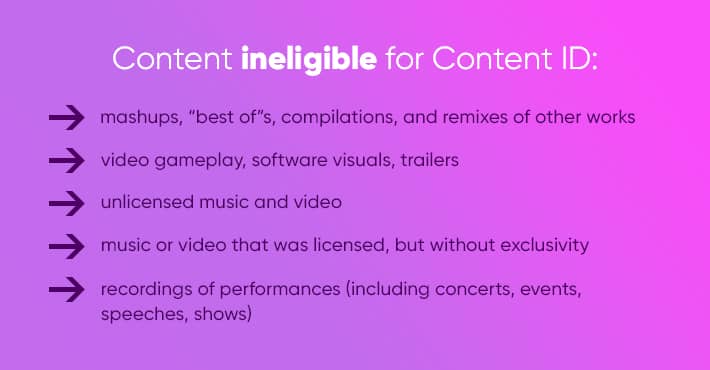
Key Takeaways:
- Content ID System: A tool that automatically scans YouTube uploads for copyright matches and enables creators to monetize, block, or track unauthorized content.
- Eligibility for Use: Not every creator can access Content ID directly; working with a YouTube partner or network is often required.
- Handling Content ID Claims: Creators can dispute invalid claims, remove or mute disputed content, or accept shared monetization in some cases.
- Fair Use Considerations: While some uses of copyrighted content may qualify as fair use, navigating this rule is tricky and may require legal advice.
- Flaws and Limitations: Content ID is highly efficient but still has limitations, including false claims and complex eligibility requirements.
Content ID is a unique and powerful tool that allows creators to not only protect their content but also earn from unauthorized uploads. Despite how efficient it all seems, the platform does not provide an easy and straightforward explanation of how an individual creator can obtain access to the system. Creators have to apply through their YouTube partnering companies to gain access. Besides this, YouTube’s requirements for applicants are strict, and violating Content ID policies and challenging the system might lead to serious consequences, from disabling access to the tool to terminating your YouTube partnership.
For over 7 years we at AIR Creator Ecosystem have been helping creators use this tool to their max advantage and to enjoy the benefits of Content ID in a stress-free manner. We’re here to answer any of your questions and happy to take care of protecting your content, maximizing your earnings, and allowing you to simply create your vision.

